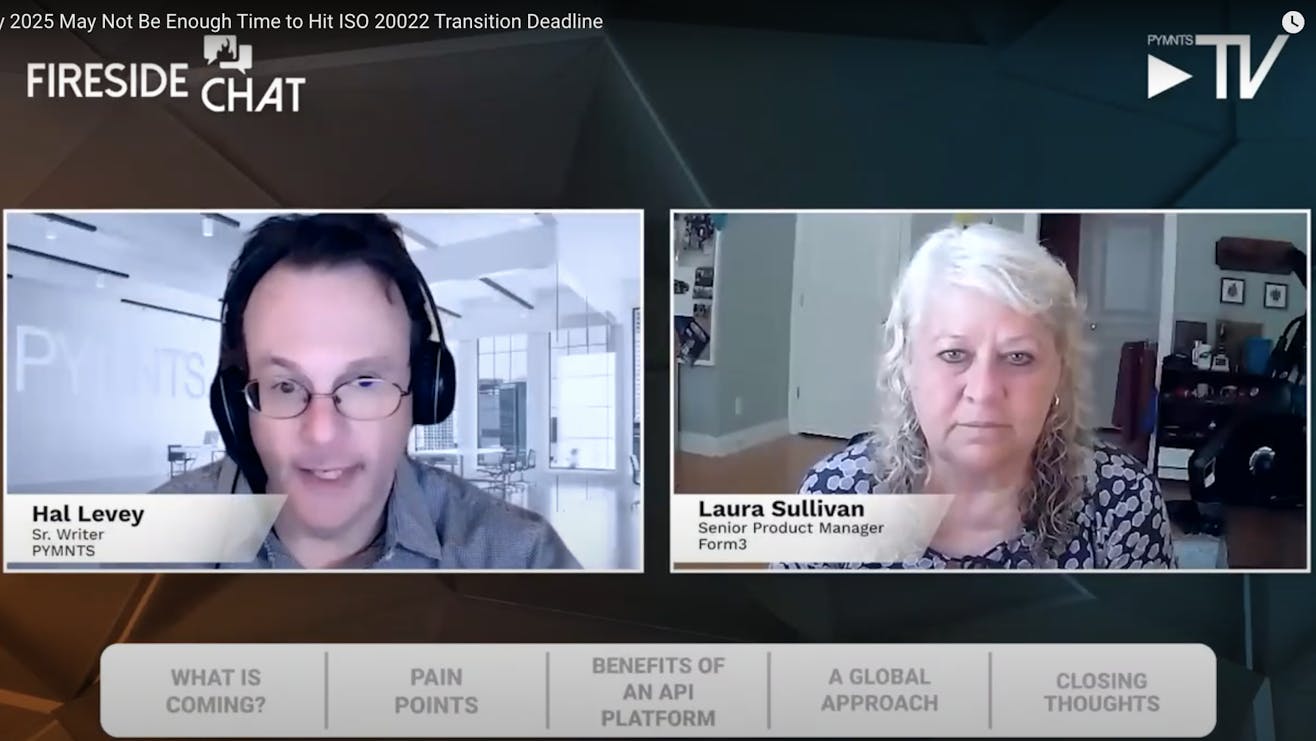Why 2025 May Not Be Enough Time to Hit ISO 20022 Transition Deadline
Thought Leadership· 3min June 22, 2023
The move to streamline and speed domestic and cross-border payments is rooted in better data exchange.
The financial services industry has been readying itself, and in some cases has found itself less-than-ready, to embrace ISO 20022, the global messaging standard that structures payments data, automates some functions and improves fraud prevention efforts.
Here in the States, the Fedwire Funds Service is migrating to ISO 20022 in March 2025.
Laura Sullivan, senior product manager at Form3, said that ISO 2022 has been discussed for the past several years and exists, she said, “as a wealth of well-structured” information that will foster a variety of new payments use cases among banks and FinTechs as they seek to innovate their offerings for enterprise clients and consumers. Now the transition, and a host of deadlines, loom.

There are already some examples out there to be gleaned from the successes seen in other countries, said Sullivan. She pointed to one use case in Canada, where a relatively small company was able to save several hundred thousand dollars a year by using the data available with ISO 20022 to “tweak and fine-tune” their accounts payable and receivable processes.
Banks, she said, have been changing from existing messaging formats to ISO 20022 — or have even been implementing brand new systems to support the demands of the new standards that will support TCH’s Real-Time Payments and FedNow.
Getting Ready for the Messaging Transformation
But for right now, the race is on to get ready. The Fedwire messaging formats have remained unchanged for decades.
“I was looking at a document that was dated from 1997,” Sullivan told PYMNTS, “and the format was relatively the same as what’s seen today. So it’s a huge change for the industry to move to ISO 20022.”
There’s some headway being made, according to Sullivan. She noted that many banks in the U.S. are getting their feet wet with SWIFT, which now supports ISO. “This will be a catalyst for banks to step back and say ‘I don’t want to keep patching my SWIFT system and my Fedwire system and my RTP system and my FedNow system. Isn’t there a better way to do this?’”
The challenge toward getting fully onboard with ISO 20022 is compounded by the fact that the data that needs to be ported over to ISO is not done on a “one-to-one” field basis. As Sullivan explained, as many as 2,000 different fields and elements need to be considered.
“And we are finding that there is some data where there really isn’t a great place to put it into an ISO format,” she said. There’s also a challenge down the line that stems from the fact that payments practice groups will mandate structured addresses.
Those mandates will prove to be a huge hurdle in the U.S., she said, because most of the addresses that are provided in wire transfers — particularly on the origination side — come from customer demand deposit systems, which don’t understand structured addresses.
“The banks are going to have to step back and look at how they can take a demand deposit system which has eight lines of address and put it into some sort of structured format,” said Sullivan. Upon doing so, she said, such standardization will wind up as a benefit to sanctions screening and scanning, identifying addresses and countries that warrant further review or even outright red flags for transactions.
To take advantage of the ultimate benefit that comes from the whole world (eventually) adhering to the same messaging format — where an instant payment can move via the RTP Network or FedNow, where ACH payments move toward instant payments rails, banks need to look for solutions and providers that can service multiple rails so that the FIs don’t have to navigate themselves. One approach is taking the steps necessary to eventually shift to ISO 20022. No easy task, considering that even in a mid-sized bank, as many as 200 internal systems can be impacted by the move to ISO standards.
“If you can start it all, and partner with someone who can put all of this information into an ISO format,” she said, “it’s a lot easier.” APIs can help make that transition, said Sullivan, as those single points of integration can work across multiple rails. APIs are high-performance, high volume, resilient and do not require banks to “queue” their payments.
She said the readiness is there, as banks have overcome any real fear of putting payments in the cloud and don’t have to wage the battle of ripping out existing bank infrastructure.
Looking ahead, she said, banks will cease having “hard and fast lines between different payment types.” Using an API to talk to networks means that banks can break down the silos within their own operations, creating de facto payment hubs where the same internal functions can work across various payment types.
“Being able to have the same process for dealing with insufficient funds, fraud checking, sanctions checking — all of that with one set of interfaces to your posting systems, to your sanction systems, to your fraud systems…we see that as the future,” she told PYMNTS.
Originally published on PYMNTS.com
Written by
Laura is a senior product manager at Form3 with responsibility for developing the Fedwire gateway product. She has 20+ years of payment processing experience at commercial banks, the Federal Reserve and FinTech companies. Prior to joining Form3, Laura was a senior director with responsibility for payments products in the Americas – Canada AFT, Canada RTR, US ACH, US FedNow, US Fedwire and US RTP – on several different payment platforms marketed by FIS. Laura began her career in operations at a large commercial bank and has held roles in operations, project management and product management primarily in the treasury payment space.









 Back to News
Back to News

